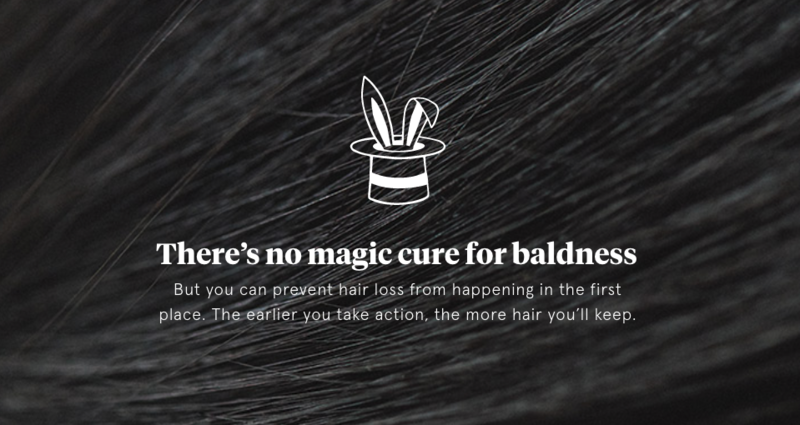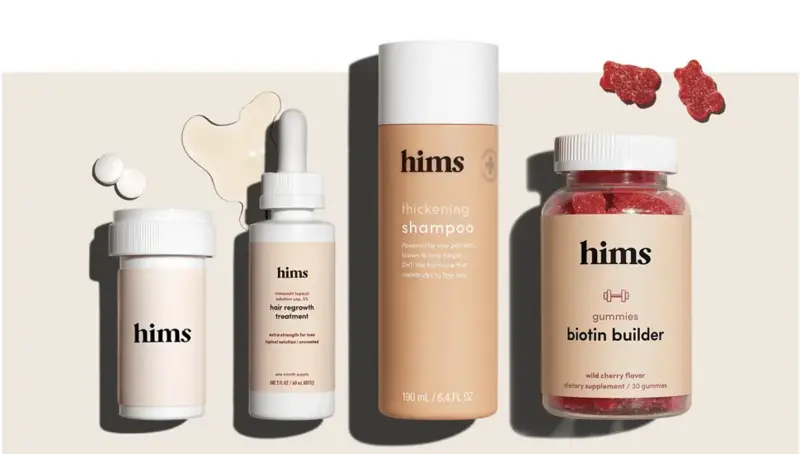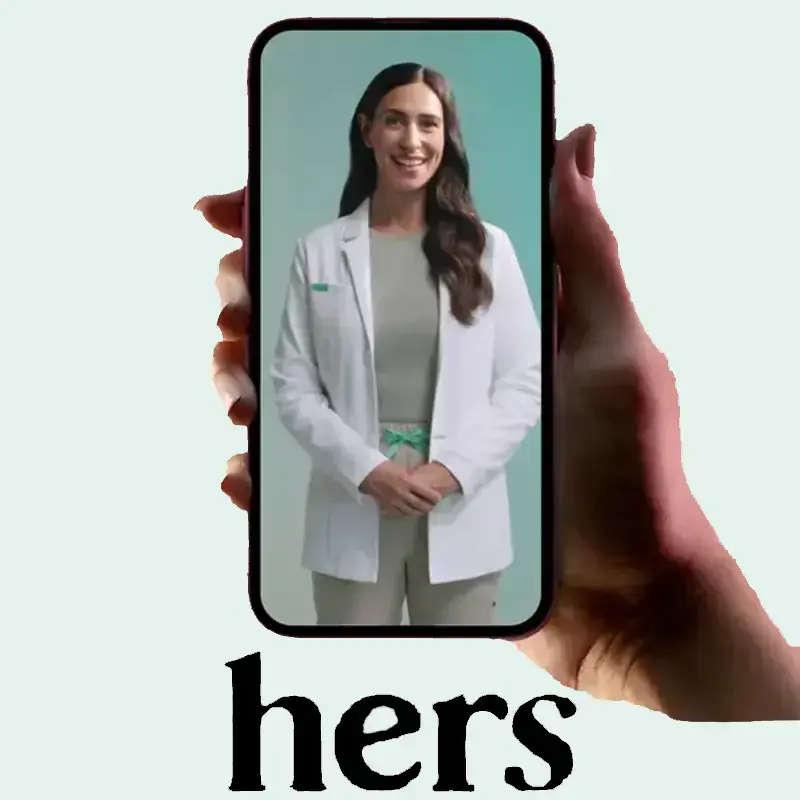Best Hair Loss Treatments
Based on In-Depth Reviews
Hair loss treatment is a billion dollar industry worldwide, but how can you tell which products work and which don't? We compare the top hair loss treatment providers.
-
200+Hours of research
-
12Sources used
-
20Companies vetted
-
4Research Criteria
-
4Top
Picks

- Types of baldness differ between men and women.
- There are currently only two FDA-approved treatments.
- Noticeable results can take months.
- There is no single cause for baldness.
How we analyzed the best Hair Loss Treatment Providers
Our list of the best Hair Loss Treatment Providers
- Additional Companies:
- Keranique
- Roots by Genetic Arts
- XYON
- Rugiet
- Rogaine
- Profollica
- HairNu
- Ultrax Labs
- Folexin
- Shapiro MD
- Keeps
- Roman
- Persona Nutrition
- Hush & Hush
- Rex MD
- Regrowth Club
- DS Laboratories Spectral DNC-N
- Patrick's RD-1 Anti-Hair Loss Spray
- Act+Acre Cold Pressed Apple Stem Cell Serum
- Lemonaid Health
- Ro
- Hair Club
- Strut Hair Loss Treatment
- Valotin
- Mango Rx
- Ivy Rx Hair Loss
- PlushCare
- LifeCell Hair Loss
- sesame care
Our Top Picks: Hair Loss Treatments Reviews
About Himsᵀᴹ
Hims is a telehealth platform that connects men with licensed medical providers for personalized hair loss care. Through a simple online consultation, a medical professional reviews your needs, and if appropriate, prescribes treatments delivered directly to your door in discreet packaging. Get access to FDA-approved ingredients like finasteride and minoxidil, clear safety guidance, free shipping on prescribed treatments, and ongoing provider support.
- Rx Treatments
- Oral Chewable (Finasteride), Oral Medication (Finasteride), Topical Spray (Minoxidil + Finasteride), Topical Serum (Minoxidil), Hair Hybrids (Finasteride + Minoxidil + Biotin/Saw Palmetto).
- Non-Rx Options
- Thickening Shampoo, Thickening Conditioner, Biotin Gummies, Hair Growth Supplements.
- Prescription Required?
- Yes — prescription required for Rx products. Complete an online consultation, and a provider will determine eligibility.
- Contract or Plan Required?
- Flexible — cancel anytime.
- Pricing
- Treatments range from $15 to $60 per month, depending on the product, strength, and whether it’s bundled.
- Delivery
- Free shipping delivered to your door in discreet packaging.
Start Your Free 2-Minute Online Consultation
Discover a personalized plan for hair loss treatment with guidance from a licensed medical provider, if appropriate. Your free online consultation takes just minutes and could be the first step toward real results.
Most Affordable Pricing

Screenshot of https://www.keeps.com/ 1/21/2020
Keeps is an online company dedicated to providing FDA-approved hair loss treatments at affordable prices. As soon as you log into the Keeps website, you’ll notice that they have decided to keep things simple and straight to the point. You are greeted by easy-to-read instructions about how their website operates, followed by an explanation of the products they offer, which are exclusively Finasteride and Minoxidil.
Despite only offering these two products, Keeps provides plenty of good supplemental reading material to make sure you are fully aware of how their products work and what potential side effects that may result from their consumption. There are also several FAQs on hair loss which include links to the relevant research papers that they take their information from.
Keeps also offers a telemedicine option so you can be connected to a hair loss specialist who will help monitor your progress and suggest a personalized treatment regimen based on your individual situation.

Screenshot of https://www.keeps.com/ 1/21/2020
At $25 for a monthly dose of Finasteride and $10 for Minoxidil—$15, if you choose the foam option—Keeps has the lowest pricing for individual doses of each treatment of all the companies we’ve reviewed. Combined with their many package deals, this makes them a great choice for anyone on a tight budget.
Keeps only offers hair loss treatments formulated for men, which leaves out the women who are affected by hair loss. They don’t offer discounts for ordering in bulk, which, given their already low prices is understandable. However, those who want to order in bulk should investigate competitors whose discounts may make large orders less expensive.
About Bosley®:
Bosley is a renowned hair restoration company specializing in both surgical and non-surgical solutions for hair loss. With over 50 years of experience, Bosley has performed more than 500,000 hair restoration procedures, helping individuals regain their confidence with natural-looking results.
- Cost Range (Surgical Hair Transplant)
- A Bosley hair transplant typically costs between $4,400 and $12,000 depending on the extent of hair loss, number of grafts, and procedure type.
- Pricing Structure
- Costs are calculated on a per‑graft basis — each graft usually includes 1–4 hair follicles. The total cost depends on how many grafts your plan requires.
- Procedure Types
- Follicular Unit Extraction (FUE) and Follicular Unit Transplantation (FUT).
- Non‑Surgical Solutions
- BosleyRx® (finasteride), Low-Level Laser Therapy (LLLT) with the Bosley Revitalizer®, Scalp Micropigmentation (SMP), and BosleyMD® hair care products.
- Financing & Payment Options
- Bosley offers financing and payment plans (via third‑party lenders) to help spread out the cost. Plans may span 24–84 months depending on your needs.
- Delivery
- Discreet delivery of non-surgical treatments and hair care products to your door.
Getting Started with Bosley®:
To explore personalized hair loss treatment options, schedule a free consultation with a Bosley hair restoration specialist. This consultation will help determine the best treatment plan for your hair loss condition and goals.
For Your Consideration
Rogaine is the first and only brand name Minoxidil-based alopecia treatment available today. Operating since the 1980’s, Rogaine as a company has dedicated itself to refining their proprietary recipe for Minoxidil-based topical treatments.
Rogaine’s strength lies in its simplicity. It does not pretend to be anything other than the only brand-name Minoxidil treatment in the market. Their website is full of helpful information about how Rogaine works and how it came to be developed, as well as a variety of documents to further your understanding of hair loss.

Screenshot of https://www.rogaine.com/ 1/21/2020
Unlike most if its competitors, Rogaine is available both online and over the counter, which makes it a readily accessible option if you need to refill your supply in short notice.
Given that it is the brand name alternative, Rogaine’s prices are higher than its competitors at $27.49 per monthly supply. However, if you order in bulk through their website, it is possible to lower the monthly cost to $12.37 per month if you choose a whole year’s worth of Rogaine.
Best Additional Hair Loss Assessment Resources
Roman is an online men’s wellness company that offers a broad range of services ranging from hair loss solutions to erectile dysfunction medication other related and sensitive topics in between. As far as their hair loss options go, Roman focuses exclusively on the two FDA-approved hair loss treatments on the market, Minoxidil and Finasteride. Finasteride is offered at $24 per monthly supply, or $20 if you order a three-month supply, while Minoxidil is offered as a topical solution for $16 per month.
While Roman’s business model is not unique, their online resources stand out as being more comprehensive than many of their competitors. They offer clear disclaimers on all their products warning you of potential side-effects and encourage you to check in with a physician to make sure you are properly informed. They also have a wealth of supplementary materials on hair loss and other topics.

Screenshot of https://www.getroman.com/ 1/21/2020
Their telemedicine services also stand out from other companies, partly because all consultations are free. Most of their competitors charge a small fee per visit. Because they use independent doctors, you are also able to verify each physician's credentials so you know who is evaluating your case.
Speaking of free services, Roman also offers free two-day shipping through their pharmacy network, which offsets a small portion of the cost of medication. Despite their wealth of resources, Roman is a male-focused company that does not offer any hair loss management options for women.

Hersᵀᴹ Review:
Hers offers access to science-backed hair loss treatments designed specifically for women experiencing hair thinning or shedding. Their platform connects users with licensed medical providers who can evaluate hair concerns and prescribe clinically proven treatments such as topical minoxidil or oral finasteride alternatives, when appropriate. Every treatment plan is personalized and shipped discreetly to your door.
- Treatments Available
- Minoxidil (2% and 5%), oral minoxidil, Biotin + Minoxidil gummies and chews, Hair Blends Serum (minoxidil, biotin, ketoconazole, finasteride), Hair Blends Postmeno Serum (finasteride and minoxidil), thickening shampoo and conditioner.
- Is a Prescription Required?
- A prescription is only needed for oral minoxidil and hair blend treatments.
- Free Delivery
- If prescribed, your treatment ships directly to your door for free.
- Costs
- Topical minoxidil ~ $15/month, biotin gummies $16/month, and prescription treatments start at $29/month, with subscription plans offering potential savings.
- Is a Contract or Plan Required?
- No long-term contract is required — treatments are offered through flexible subscription plans that you can adjust or cancel anytime.
Get Started with Hers™
Find your personalized hair loss treatment with a recommendation from a licensed medical provider, if appropriate. Click on the image below to get started with your free online consultation, it only takes a few minutes!
Keranique Review:
Keranique is a hair regrowth brand created exclusively for women, offering treatments formulated with the only FDA-approved ingredient clinically proven to regrow hair. Trusted by millions, Keranique combines science-backed solutions with a commitment to helping women restore confidence through thicker, fuller, healthier-looking hair.
- Treatments Available
- Offers a complete four-step Regrowth System (shampoo, conditioner, Minoxidil treatment, and Lift & Repair spray), plus standalone hair regrowth treatments, serums, scalp supplements, stylers, and kits.
- Is a Prescription Required?
- No—Minoxidil regrowth treatment and all products are available over the counter.
- Free Delivery
- Included with Auto-Delivery (subscription) purchases of the Regrowth System.
- Costs
- Individual regrowth treatment ~$29; full Regrowth System bundles between ~$85–115; other products range ~$30–50.
- Contract or Plan Required?
- No long-term commitment. Auto-Delivery is optional and offers flexibility to skip, pause, or cancel at any time.
Getting Started with Keranique
Choose the Keranique Regrowth System or individual treatments online, then select a one‑time purchase or Auto‑Delivery for convenience and savings. No prescription is required—place your order and have it shipped directly to your door.

About Rugiet
Rugiet is a telehealth company that provides personalized treatments reviewed by board-certified doctors and shipped discreetly to your door. Its 2-in-1 “Grower” option combines prescription-strength tadalafil with minoxidil to support erectile function and promote hair growth with once-daily use. You’ll complete a secure online questionnaire, a clinician evaluates whether treatment is appropriate, and you get ongoing follow-ups. The platform is HIPAA-compliant and lists LegitScript certification.
- Rx Treatments
- Grower: once-daily compounded formula combining tadalafil (for erectile function) and oral minoxidil (for hair regrowth).
- Prescription Required?
- Yes — Grower requires an online consultation and approval from a board-certified doctor before prescribing.
- Contract or Plan Required?
- No long-term contract. Flexible subscription with the ability to pause, skip, or cancel anytime.
- Pricing
- As low as $1.63 per dose, depending on plan and frequency.
- Delivery
- Free shipping to your door in discreet packaging.

More insight into our methodology
FDA Approval
Hair loss is a widespread condition that affects a surprising number of people. This naturally means that there are many companies that will gladly offer up “guaranteed” solutions to an issue that affects so many on such a personal level. However, there are currently only two FDA-approved treatments that have undergone proper study and research. We chose only companies that offer these treatments to ensure that you’re looking at credible products with replicable results.
Cost Over Time
Hair loss treatment is a process. There is no magic pill that will make your hair grow back permanently, meaning that once you start treatment, you will have to continue for the rest of your life, or your hair will start falling out again. We picked out companies that offer reasonably-priced products to make sure that your treatment doesn’t require you to sacrifice the rest of your budget.
Additional Resources
Despite the fact that approved hair loss treatments can be counted on one hand, the process of treating your hair loss involves more than just medication. We chose companies that offer additional resources such as online ordering and telemedicine options to make sure you have access to as many tools as possible in the course of your hair loss treatment regimen.
Transparency
As mentioned earlier, many companies will gladly announce that they have a “guaranteed” hair loss solution for you, even though these statements are not supported by current research. We chose companies that are upfront about the fact that the subject of hair loss treatments is a complicated one with no guaranteed solutions.
Helpful information about Hair Loss Treatments
Hair loss affects people from all walks of life. Most people will experience hair loss naturally as a result of aging, but a significant portion of the U.S. population will find themselves dealing with the symptoms far earlier than they would feel comfortable with. Indeed, according to the American Hair Loss Association approximately 85% of men will experience significant hair thinning or loss by age 50, while 80% of women will experience some form of it by age 60.
While many learn to live with this affliction, many others would instead prefer to keep their hair one way or another. From cosmetic solutions such as wigs and hair pieces, to medical options like topical and oral treatments or hair restoration surgery, many hair loss sufferers express interest in regaining their former appearance. It’s no surprise then, that the hair loss treatment industry generated close to 4 billion USD in 2019.
And yet, despite the evidence that many would prefer to keep their head of hair, there is a surprisingly small number of options for combating and reversing the hair loss process. Perhaps due to the fact that hair loss is not a life-threatening condition, it is possible that it has not been taken as seriously as other afflictions, even though it has been documented that it can have significant psychological effects on those who face it.
Do the existing treatment options work? The answer is not as straightforward as it might seem. Unfortunately, due to the lack of authoritative research into the matter, the available remedies can range from only moderately effective to not at all, depending on each individual case.
Splitting Hairs
The difficulty of treating hair loss stems from the fact that there are myriad possible causes for it, and they affect people in many different ways. Men, women, and even children of all ages are affected by different types of alopecia. This lack of a single root cause means that there is no universal solution to hair loss. Each case requires careful examination in order to properly manage the symptoms.
It is useful to note that alopecia is the broader, clinical term for hair loss disorders. Normally, people lose anywhere from 25-100 hairs on a daily basis, with that rate increasing as one ages. Some, however, begin experiencing hair loss at a much faster rate. It is this abnormal rate of hair loss that is generally referred to as alopecia.
Within its many subclassifications, androgenetic alopecia is the most common, responsible for up to 95% of cases in men and 40% of women overall by age 50. In a nutshell, androgenetic alopecia, or hereditary hair loss, causes your hair follicles to shrink over time, slowing down the pace of hair growth. This causes your hair to thin out at first, until the follicle is completely closed, unable to produce new hairs after they fall out.
While the term “androgenetic alopecia” is used when talking about both male and female hereditary hair loss, there is a difference in how they manifest. Male pattern baldness starts manifesting around the temples and works its way to the back of the head, forming an ‘M’ shape. Eventually, the crown or center of the head starts thinning out as well, until eventually most or all hair is gone.
Female pattern baldness, on the other hand, rarely results in complete hair loss, limiting itself to thinning on the crown in most cases. Incidentally, this is also the type of alopecia responsible for the myth that baldness is only inherited from the mother’s side of the family, given its genetic component.
The other major type of hair loss is alopecia areata. This particular variant of alopecia affects two percent of people at some point or another throughout their lives. Although research into the various types of alopecia is still ongoing, alopecia areata is currently classified as an autoimmune disorder. This means that the hair loss is caused by the hair follicles being attacked by a person’s immune system, as opposed to the accelerated shrinkage caused by androgenetic alopecia.
Given its autoimmune nature, there is also the possibility of alopecia areata being a symptom of something larger, as is the case with polycystic ovary syndrome and certain thyroid disorders, to name a few scenarios.
Aside from the previously mentioned types, there are other forms of alopecia that are caused by damage to the hair follicles under various circumstances. Chemotherapy, for example, is famously associated with hair loss. Abrasive hair styling techniques such as tightly pulling one’s hair, excessive coloring, perming or relaxing of hair could also lead to hair loss. Other factors such as trichotillomania, a condition where a person pulls their hair unconsciously due to stress, can also lead to permanent hair loss.
We spoke with a nurse who wished to remain anonymous, and she confirmed that stress can also cause hair to fall out, even if you’re not actively pulling it due to trichotillomania. She shared the story of a patient whose stress levels were so consistently high that the Finasteride regimen the patient was going through was ineffective. It later turned out that once the patient found a way to reduce their stress levels, their hair gradually grew back as intended.
Gone Today, Hair Tomorrow?
As has been mentioned earlier, there are many causes for hair loss, and just as many alleged “cures” for it. However, as of this writing, there are only two FDA-approved treatments that have been properly tested and vetted.
One of these products is Minoxidil, known commercially as Rogaine. Minoxidil—when used as an alopecia treatment—is a topical solution, sometimes presented as a foam that helps promote hair regrowth in whichever area of the body it is applied to. Officially, the FDA has only approved Minoxidil for use in treating androgenetic alopecia and female pattern hair loss, however, research shows that it is often used for off-label treatment of other types of alopecia.
Minoxidil is of particular interest to hair loss researchers, since even though it has been proven effective to a certain degree, the exact mechanism through which it achieves hair regrowth is not yet fully understood. It is also the only one of two treatments that is safe for women to use when treating hair loss.
The other approved hair loss treatment is Finasteride. This is a drug that was originally created to treat benign prostatic hyperplasia, which it achieved by reducing the size of an abnormally enlarged prostate. However, it was eventually discovered that Finasteride also promoted scalp hair growth in men by blocking the very same enzymes that caused the enlarged prostate symptoms it was originally created to combat.
While Finasteride is ostensibly a more consistently effective treatment than Minoxidil, with some studies showing up to 48% of their participants actually regrowing hair rather than just slowing down the hair loss process, it is not without noticeable side effects. One of these is a notable decrease in libido, or outright erectile dysfunction in some cases. Given the fact that one of the main concerns in treating male pattern baldness is the psychological impact such a condition can have on men, these particular side effects are not insignificant.
Because Finasteride interacts with enzymes closely associated with testosterone and the role it plays in the development of male traits, it is often accompanied by a warning that it should not be used by women under any circumstances.
There is also, of course, the option of hair transplant surgery. Hair transplant surgery is a fairly popular, if expensive option for combating hair loss. As with the other available treatments, there are different methods of performing hair transplant surgery for different cases of alopecia, but the principle remains largely the same. Healthy hair follicles from other parts of the patient’s body—normally the back of the scalp, although alternatives are being researched—are transplanted into the impacted areas so that hair can begin to grow anew.
One common concern about this procedure is the fact that it requires incisions be made into the scalp, leaving visible scars that seem counterproductive to the goal of making your head of hair look whole again. This is acknowledged by experts in the field and ways to minimize the scarring is being researched, although the outcome will depend largely on the skill and competence of your surgeon.
When considering this sort of treatment, however, it is important to recognize a few key details. It is a surgical procedure, meaning that this is something that requires extensive consultation with a qualified physician prior to choosing to go ahead with it. This cannot be emphasized enough: some hair transplant procedures are being performed by unqualified individuals exploiting loopholes in state medical board requirements.
One also needs to keep in mind that success rates are largely self-reported and choosing a reputable and experienced surgeon is key when making this type of decision.
The actual effectiveness of the procedure is also a mixed bag in terms of results. While it no doubt has worked for a great number of people since its inception, it is important to be prepared for the possibility that it might not work for you.
As with all things related to medicine, it is incredibly important to consult a physician before interacting with these treatments in any way shape or form. A medical professional will be able to properly determine the exact nature of your baldness symptoms and chart out the appropriate treatment plan for you.
The Trouble with Supplements
There is still much research to be done on the topic of hair loss. Because it can often be a symptom and not the actual condition itself, there is no definitive way to tackle it and no way to guarantee that you’ll be able to stave off its advance well into your later years.
The currently approved and tested hair loss remedies were not initially developed with hair loss in mind, and even then they only address very specific aspects of the condition which may or may not be a viable alternative for certain types of hair loss. Perhaps due to the currently limited scope of vetted treatments, you may notice that there are a staggering number of products that advertise themselves as being a natural alternative to combat hair loss.
Many will make claims that they are “FDA approved.” Given that most, if not all of these are supplements, they are not under the direct purview of the FDA and as such, not subject to the same scrutiny as Minoxidil and Finasteride. If the companies that manufacture and market these alternative treatments are being transparent, they will state that their supplements are manufactured in FDA-approved facilities, which means they operate in an environment deemed safe by the FDA. That does NOT, however, say anything about the effectiveness of their products.
The nurse we spoke with mentioned that some dermatologists and hair transplant experts do use supplements as a means to promote healthier hair in their patients, but it is not the main focus of the hair loss treatments and are not the mechanism through which hair growth is achieved.
Sometimes blood work is performed to determine which compounds the patient is low on, so their doctors can recommend the appropriate supplements. While there is some evidence that being deficient in certain vitamins and minerals can be a contributing factor in hair loss, the physician in charge must first evaluate the patient prior to recommending the use of these supplements.
FAQs about Hair Loss Treatments
Is there any way to stop my hair loss permanently?
Currently, there is no known permanent solution to hair loss. The effectiveness of treatment depends on a variety of factors which are different for each individual. Speak with your doctor for proper guidance and alternatives.
Are natural alternatives to hair loss drugs any good?
Most ‘natural alternatives’ to hair loss treatments are actually supplements, which have not been evaluated by the FDA for their effectiveness at combatting hair loss.
Hair loss treatment worked for a friend, but not for me. Why?
The science of hair loss and hair loss remedies is not yet fully understood. What works for one person may not work for you. Consult a physician to properly evaluate your situation and provide the best course of action.
Our Hair Loss Treatments Review Summed Up
| Company Name | The Best for |
|---|---|
| Hims Hair Loss Treatments | Male and Female Hair Loss Options |
| Keeps Hair Treatment | Affordable Pricing |
| Roman Hair Loss Treatment | Additional Hair Loss Assessment Resources |











